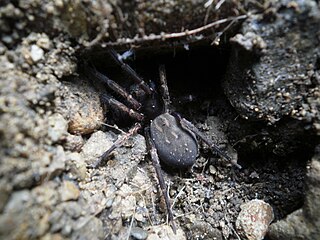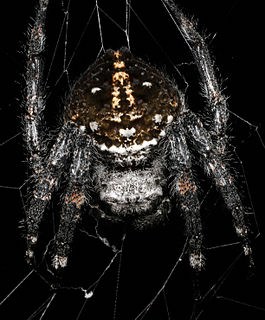
Nursery web spiders (Pisauridae) is a family of araneomorph spiders first described by Eugène Simon in 1890. They resemble wolf spiders (Lycosidae) except for several key differences. Wolf spiders have two very prominent eyes in addition to the other six, while a nursery web spider's eyes are all about the same size. Additionally, female nursery web spiders carry their egg sacs with their jaws and pedipalps instead of attaching them to their spinnerets as wolf spiders do. When the eggs are about to hatch, a female spider builds a nursery "tent", places her egg sac inside, and stands guard outside, hence the family's common name. Like the wolf spiders, however, the nursery web spiders are roaming hunters that don't use webs for catching prey. They have a wide variety of prey, and larger species may prey upon vertebrates, particularly amphibians and fish.

Ant spiders are members of the family Zodariidae. They are small to medium-sized eight-eyed spiders found in all tropical and subtropical regions of South America, Africa, Madagascar, Australia-New Guinea, New Zealand, Arabia and the Indian subcontinent. Most species are daytime hunters and live together with ants, mimicking their behavior and sometimes even their chemical traits. Although little is known about most zodariids, members of the genus Zodarion apparently feed only on ants; a number of other genera in the family are apparently also ant specialists.

Aelurillus is a genus of spiders in the family Salticidae.

Barychelidae, also known as brushed trapdoor spiders, is a spider family with about 300 species in 42 genera. Most spiders in this family build trapdoor burrows. For example, the 20 millimetres (0.79 in) long Sipalolasma builds its burrow in rotted wood, with a hinged trapdoor at each end. The 10 millimetres (0.39 in) long Idioctis builds its burrow approximately 5 centimetres (2.0 in) deep, just below the high tide level, sealing the opening with a thin trapdoor.

Archaeidae, also known as assassin spiders and pelican spiders, is a spider family with about ninety described species in five genera. It contains small spiders, ranging from 2 to 8 millimetres long, that prey exclusively on other spiders. They are unusual in that they have "necks", ranging from long and slender to short and fat. The name "pelican spider" refers to these elongated jaws and necks used to catch their prey. Living species of Archaeidae occur in South Africa, Madagascar and Australia, with the sister family Mecysmaucheniidae occurring in southern South America and New Zealand.

Thwaitesia is a genus of comb-footed spiders that was first described by Octavius Pickard-Cambridge in 1881.
Damastes is a genus of East African huntsman spiders that was first described by Eugène Louis Simon in 1880. It is classified under the family Sparassidae, though its subfamilial classification remains unclear. The subspecies Damastes coquereli affinis is a nomen dubium.

Thomisus is a genus of crab spiders with around 150 species described. The genus includes species that vary widely in their ecology, with some that ambush predators that feed on insects visiting flowers. Like several other genera in the family Thomisidae, they are sometimes referred to as flower crab spiders, from their crab-like motion and their way of holding their front legs, reminiscent of a crab spreading its claws as a threat.

Uliodon is a genus of spiders endemic to New Zealand and possibly Australia. They are commonly referred to as vagrant spiders. Vagrant spiders vary in colour from dark brown to almost black, they typically have a body length of 20mm and a 50mm leg span. When alive, the interior of the male’s pedipalp are brightly coloured.

Darwin's bark spider is an orb-weaver spider that produces the largest known orb webs, ranging from 900 to 28,000 square centimetres, with bridge lines spanning up to 25 metres (82 ft). The spider was discovered in Madagascar in the Andasibe-Mantadia National Park in 2009. Its silk is the toughest biological material ever studied, over ten times tougher than a similarly-sized piece of Kevlar. The species was named in honour of the naturalist Charles Darwin, with the description being prepared precisely 150 years after the publication of The Origin of Species, on 24 November 2009.

Ero is a genus of pirate spiders first described in 1836. They resemble comb-footed spiders due to their globular abdomen, which is higher than it is long.

Triaeris stenaspis is a species of spider in the family Oonopidae, with a pantropical distribution. It is also found in Iran and has been introduced into Europe. A very small spider, with a maximum body length of under 2 mm (0.08 in), it has been shown to prey successfully on springtails. Only females have ever been found, and the species may be parthenogenetic, being able to produce female offspring from unfertilized eggs.

Udubidae is a family of araneomorph spiders, most of whose members were formerly placed in the family Zorocratidae, which is no longer accepted.
This page lists all described species of the spider family Viridasiidae accepted by the World Spider Catalog as of December 2020:
Zorodictyna is a genus of spiders in the family Udubidae native to Madagascar. It has been described as an intermediate genus between Zoropsidae and Dictynidae, though it is now placed in Udubidae. This genus was originally placed in the family Zoropsidae, but it has been reassigned several times since. In 1967, Lehtinen moved it to Miturgidae. In 1999, it was moved back to Zoropsidae, and in 2015, it was moved to Udubidae.
Zorodictyna inhonesta is a species of spider in the family Udubidae, found in Madagascar. It was first described by Eugène Simon in 1906 as Uduba inhonesta. Pekka T. Lehtinen transferred it to the genus Zorodictyna in 1967, although Pierre L.G. Benoit was still using the name Uduba inhonesta in 1972.

Viridasius is a monotypic genus of East African araneomorph spiders in the family Viridasiidae, containing the single species, Viridasius fasciatus. It was first described by Eugène Simon in 1889, and has only been found in Madagascar.
Cyriogonus is a genus of African crab spiders that was first described by Eugène Louis Simon in 1886.












